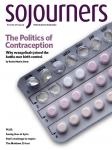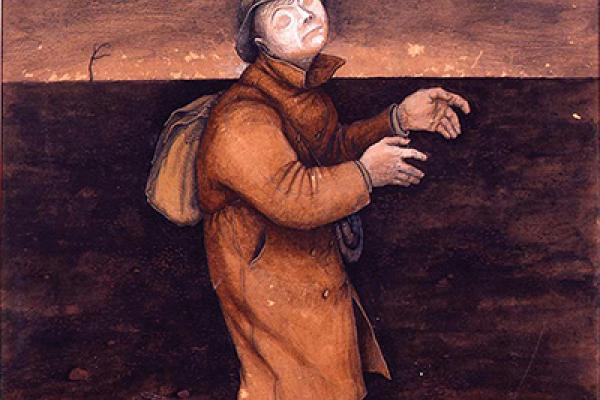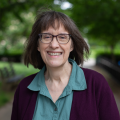CANADIAN ARTIST William Kurelek was influenced both by his experiences with mental illness and his conversion to Catholicism. He would eventually be considered psychiatrically recovered, but he was institutionalized as a young man in the mid-’50s, during which he created one of his best known early paintings, showing a blind man wandering in a desert, captioned “Where am I? Who am I? Why am I?”
These are foundational questions for all of us, not just a gifted artist in a time of suffering. The institutional church tends to assert that the answers to such questions are, if not simple, at least imminently knowable: Just pull up a pew and stay awhile. Many of us who are already believers come to assume that our job is to have a spiritual GPS always on, ready to point others in the “right” direction.
But of course, finding God or our place in the universe has rarely been that easy. Church may or may not be the place where we who are lost are found. The person we’ve always claimed to be may be shattered by unexpected events or discoveries. Or theologies that we once took for granted may come to ring hollow. As Diana Butler Bass writes in her new book, Grounded: Finding God in the World, “millions of people are navigating the space between the secular world and conventional theism. They are making a path between the two that nevertheless embraces both, finding a God who is a ‘gracious mystery, ever greater, ever nearer’ through a new awareness of the earth and in the lives of their neighbors.”
Several other very distinct books released this year wrestle with the shape of faith, finding or naming God, and how secrets revealed can shift our self-understanding and shake even our deepest beliefs.
In her best-selling 2013 spiritual memoir, Pastrix: The Cranky, Beautiful Faith of a Sinner & Saint, Nadia Bolz-Weber described her journey from fundamentalist childhood to alcoholic rebel to believer with a priestly call. A tattooed, weight-lifting former standup comedian who is now a Lutheran (ELCA) pastor, Bolz-Weber helped found House for All Sinners and Saints in Denver, which combines ancient liturgy and theological orthodoxy with artistic expression, social justice, and radical inclusion.
Bolz-Weber’s new book, Accidental Saints: Finding God in All the Wrong People (Convergent Books), delves further into her experiences as a pastor. Through stories of parishioners, friends, and people she wishes she didn’t have to deal with (who are sometimes one and the same), Bolz-Weber testifies to the presence of God in the unlikeliest of human vessels, including herself. This is integral to the book’s theme—that God is on the move in the world, just not always or even usually where our Christian cultural assumptions tell us to look, and grace is real. Accidental Saints is elevated by Bolz-Weber’s skilled storytelling, characterized by both theological insight and a comic’s timing. Like other pastor-writers before her, she reflects on personal encounters, church services, and scriptures, but unlike many, she usually dodges the all-too-common pitfall of spiritual sentimentality.
Heidi B. Neumark is also a Lutheran pastor and gifted writer; her award-winning 2003 book Breathing Space: A Spiritual Journey in the South Bronx drew on her nearly 20 years of shepherding a congregation in an urban community racked by poverty, violence, and systemic injustice.
Neumark delves into a very different topic in her new book, Hidden Inheritance: Family Secrets, Memory, and Faith (Abingdon Press). Long after her father’s death, she discovers that her father, who immigrated to the U.S. in 1938, had hidden his Jewish heritage. She did not know that her well-off paternal grandparents were deported in 1943 from Germany to the Theresienstadt concentration camp in what is now the Czech Republic, having given money to the Nazi government for what they thought was living space in a comfortable old-age home. Only her grandmother survived the ordeal.
As Neumark plunges into historical research, she finds herself facing religious resonance and dissonance. The Jewish tradition of tikkun olam (repairing the world) seems to her like an ancestral root to a lifetime of pastoral and organizing work. But Neumark must also struggle with how the Lutheran tradition in which she was raised and ordained contains deadly strands of anti-Semitism. Although very aware that Christian theology has long been twisted to endorse persecution of the Jewish people, it was an especially painful jolt to examine more deeply, for example, how the sacraments she loves were sometimes used as weapons of forced assimilation.
This moving book explores the power of family secrets and the power of bringing them to light, woven together with history, biblical insights, and the relevance of the past to contemporary justice issues.
When Leah Gunning Francis, an assistant professor of Christian education and associate dean of contextual education at Eden Theological Seminary in St. Louis, saw the TV news the day Michael Brown was shot in nearby Ferguson, she knew nothing would ever be the same for her city. Soon she realized that her faith and vocation would also be forever changed. In Ferguson and Faith: Sparking Leadership and Awakening Community (Chalice Press), Gunning Francis frames interviews she conducted with area clergy and with some of the youth leaders who initiated and have sustained the organizing in Ferguson. Some of the clergy had never participated in street actions before, and few were used to taking their cues from non-church-going young people. But over the course of months, many religious leaders found new facets of their vocation—learning to follow the lead of the organizers and leveraging their status or resources on the organizers’ behalf when possible, staying in the streets even when some congregations grumbled, providing pastoral care in new and humble ways, and finding a new way of being church on the streets without stumbling over doctrinal beliefs (or unbelief).
As one organizer, Millennial Activists United cofounder Brittany Ferrell, described it: “I feel like there’s this perpetuated idea that ‘church’ is something you go to, and it’s been proven wrong within the last six months, because church has come to us whether we welcomed it or not.” David Gerth, executive director of an interfaith organizing coalition, had a similar revelation from the clergy side when watching the protesters early on. “[T]he image for me is that their feet drilled into the core of the earth and they were pulling out raw magma. ... it’s just this level of power. And I know that’s not exactly a theological image, but, for me, then I recognized, ‘The spirit of God is in this place. Whether they’re claiming it or not, I’m claiming it.’”
Ferguson and Faith is a firsthand account of one of the most important currents in U.S. society right now, an informal handbook for clergy who want to take action, and a powerful antidote to mainstream media stories and images that continue to ignore the commitment, intelligence, strategy, and integrity of the young people organizing for long-denied justice.
When best-selling author and popular blogger Rachel Held Evans released her book Searching for Sunday: Loving, Leaving, and Finding the Church (Thomas Nelson) last spring, some took the book as final confirmation that she is an apostate, a traitor to her evangelical heritage. It is, after all, organized according to the seven sacraments, and ends with how she and her husband have ended up finding a home in the Episcopal church. (Although her open and affirming stance toward LGBTQ people is probably the real kicker.) For others—evangelicals who share her theological and social concerns, or who also love the sacraments—she’s simply a very good writer who reflects and reports from a position of open-hearted orthodoxy.
For Held Evans, different churches have been a mix of loving community and doctrinal frustration, idealistic dreams and disappointing realities. This is a journey that many readers, from a variety of upbringings, can relate to. But her self-awareness and faith in a bigger picture are hopeful. She writes, “Sometimes I wonder how much I’ve missed because I haven’t bothered to look, because I wrote off that church or that person or that denomination because I assumed God to be absent when there is not a corner of this world that God has abandoned.”
Finally, in Wearing God: Clothing, Laughter, Fire, and Other Overlooked Ways of Meeting God (HarperOne), Lauren F. Winner, an author and Episcopal priest, invites readers to move beyond the greatest hits of biblical metaphors for God. Winner’s prose is both lyrical and learned, seamlessly blending Christian tradition, scriptural interpretation, social history, and personal experiences (from a sweet country altar to a women’s prison) with touches of humor: “In calling Himself ‘the bread of life’—and not, say, crème caramel or caviar—Jesus is identifying with basic food, with sustenance. ... No one holds caviar riots; people riot for bread.”
These meditations on smell, laughter, and other metaphors and images for God aren’t mere linguistic doodling: As Winner notes, how we name or imagine God affects everything from our mental health to society and politics to, of course, our spirituality. When God seems most distant or abstract, it might be time to follow laughter to a new understanding of divine subversion.

Got something to say about what you're reading? We value your feedback!

